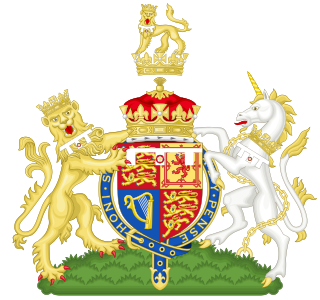
Duke of Edinburgh, named after the city of Edinburgh in Scotland, is a substantive title that has been created four times since 1726 for members of the British royal family. It does not include any territorial landholdings and does not produce any revenue for the title-holder.

Duke of York is a title of nobility in the Peerage of the United Kingdom. Since the 15th century, it has, when granted, usually been given to the second son of English monarchs. The equivalent title in the Scottish peerage was Duke of Albany. However, King George II and King George III granted the titles Duke of York and Albany.

Duke of Gloucester is a British royal title, often conferred on one of the sons of the reigning monarch. The first four creations were in the Peerage of England and the last in the Peerage of the United Kingdom; the current creation carries with it the subsidiary titles of Earl of Ulster and Baron Culloden.
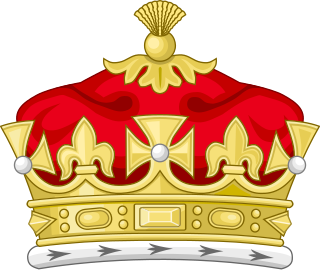
Duke of Clarence was a substantive title created three times in the Peerage of England. The title Duke of Clarence and St Andrews has also been created in the Peerage of Great Britain, and Duke of Clarence and Avondale and Earl of Clarence in the Peerage of the United Kingdom. The titles have traditionally been awarded to junior members of the English and British Royal Family, and all are now extinct.

Duke of Kent is a title that has been created several times in the peerages of Great Britain and the United Kingdom, most recently as a royal dukedom for the fourth son of King George V. Since 1942, the title has been held by Prince Edward, Queen Elizabeth II's cousin.

Duke of Cambridge is a hereditary title of nobility in the British royal family, one of several royal dukedoms in the United Kingdom. The title is named after the city of Cambridge in England. It is heritable by male descendants by primogeniture, and has been conferred upon various members of the British royal family several times throughout history.
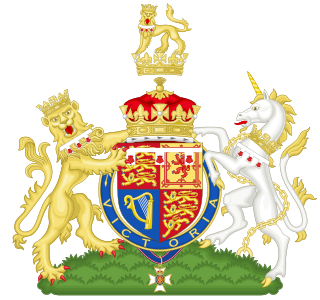
Duke of Sussex is a substantive title, one of several royal dukedoms, that has been created twice in the Peerage of the United Kingdom. It is a hereditary title of a specific rank of nobility in the British royal family. It takes its name from the historic county of Sussex in England.

Earl of Leicester is a title that has been created seven times. The first title was granted during the 12th century in the Peerage of England. The current title is in the Peerage of the United Kingdom and was created in 1837.
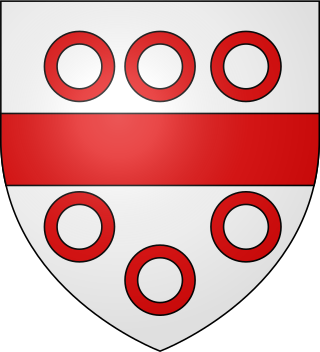
Baron Lucas is a title that has been created twice in the Peerage of England. The second creation is extant and is currently held with the title Lord Dingwall in the Peerage of Scotland.

Baron Strange is a title which has been created four times in the Peerage of England. Two creations, one in 1295 and another in 1326, had only one holder each, upon whose deaths they became extinct. Two of the creations, that of 1299 and that of 1628, are extant. The surname Le Strange was Latinized as Extraneus. The arms of Le Strange of Knockin Castle in Shropshire were: Gules, two lions passant argent.

Duchess of Kent is the principal courtesy title used by the wife of the Duke of Kent. There have been four titles referring to Kent since the 18th century. The current duchess is Katharine, the wife of Prince Edward. He inherited the dukedom on 25 August 1942 upon the death of his father, Prince George, the fourth son of George V.

The title of Viscount Lisle has been created six times in the Peerage of England. The first creation, on 30 October 1451, was for John Talbot, 1st Baron Lisle. Upon the death of his son Thomas at the Battle of Nibley Green in 1470, the viscountcy became extinct and the barony abeyant.

The title of Earl of Inverness was first created in 1718 in the Jacobite Peerage of Scotland, together with the titles Viscount of Innerpaphrie and Lord Cromlix and Erne, by James Francis Edward Stuart for the Honourable John Hay of Cromlix, third son of the 7th Earl of Kinnoull. He was created Duke of Inverness in 1727, but both titles became extinct upon the death of the grantee in 1740.
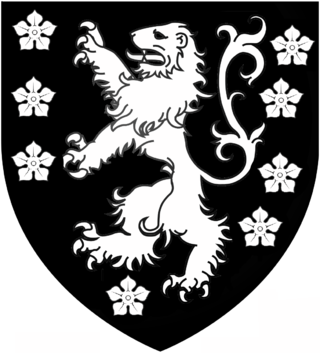
Baron Clifton, of Leighton Bromswold in the County of Huntingdon, is a title in the Peerage of England. It was created in 1608 for Sir Gervase Clifton, who made Prebendal house which was built by John Thorpe and later owned by the Clifton baronets branch of the family. The peerage was created by writ, which means that it can descend through both male and female lines. Lord Clifton died without surviving male issue and was succeeded by his daughter Katherine, the second Baroness. She married Esmé Stewart, 3rd Duke of Lennox. They were both succeeded by their eldest son James, the fourth Duke and third Baron. When he died the titles passed to his son, the fifth Duke and fourth Baron. On his death in 1660 at the age of 11, the barony separated from the dukedom. The barony was inherited by the late Duke's sister Mary, the fifth Baroness. She married Richard Butler, 1st Earl of Arran, but died aged only 18. She was succeeded by her first cousin the sixth Duke of Lennox, who became the sixth Baron Clifton as well. He was the son of Lord George Stuart, the fourth son of the third Duke and the second Baroness Clifton. On his death, the barony and dukedom again separated.

Henry Scott, 3rd Duke of Buccleuch and 5th Duke of Queensberry KG FRSE was a Scottish nobleman and long-time friend of Sir Walter Scott. He is the paternal 3rd great-grandfather of Princess Alice, Duchess of Gloucester, and the maternal 4th great-grandfather of Prince William of Gloucester and Prince Richard, Duke of Gloucester.
The title Baron Ferrers of Chartley was created on 6 February 1299 for John de Ferrers, son of Robert de Ferrers, 6th Earl of Derby. The daughter of the 6th Baron Ferrers of Chartley, Anne, married Walter Devereux who was summoned to parliament as Lord Ferrers in her right. Their descendants became Earls of Essex and the peerage was forfeited in 1601 on the attainder of Robert Devereux, 2nd Earl of Essex, but restored to his son Robert in 1604, on whose death in 1646 the peerage fell into abeyance. The abeyance was terminated in 1677 when Robert Shirley, a grandson of one of the sisters of the 3rd Earl of Essex, was summoned as Lord Ferrers of Chartley with precedence to the original creation. In 1711, Shirley was created the 1st Earl Ferrers, but the Earldom and Barony separated at his death, the barony going to Elizabeth Shirley, the daughter of his eldest son, while the earldom went to his second son. On the 1741 death of Elizabeth Shirley, 15th Baroness Ferrers of Chartley and wife of the Earl of Northampton, the peerage again briefly fell into an abeyance that was resolved in 1749 by the death of two of the three heiresses, leaving the surviving daughter, Charlotte Compton, wife of the Marquess Townshend, as 16th Baroness Ferrers of Chartley. The barony continued, merged with the marquessate, until the death of George Ferrars Townshend, 3rd Marquess Townshend in 1855, when it again fell into abeyance between his two sisters and their heirs. It remains in abeyance.

Caroline Townshend, 1st Baroness Greenwich was a British peeress, the daughter and eldest child of John Campbell, 2nd Duke of Argyll, and his wife, the former Jane Warburton. She was a sister of the diarist Lady Mary Coke.
John Thomas Townshend, 2nd Viscount Sydney of St Leonards was a British peer and Member of Parliament.

Francis Scott, Earl of Dalkeith was a Scottish nobleman.

Duchess of Edinburgh is the principal courtesy title held by the wife of the Duke of Edinburgh. There have been five Duchesses of Edinburgh since the title's creation. Following the accession of Charles III in 2022, the Dukedom of Edinburgh merged in the Crown. Following his parents’ wishes, on 10 March 2023, Charles III conferred the title Duke of Edinburgh to his youngest brother, Prince Edward, and his wife, Sophie, became the Duchess of Edinburgh.



















